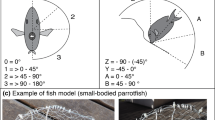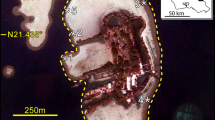Abstract
During the past decade, the relative abundance of the brown macroalgae Dictyota spp. has been high in the Florida Keys. Recent studies have shown that members of this genus successfully reproduce via vegetative fragmentation. To investigate the importance of fragmentation on the reef community, this study examined: (1) the degree of epiphytism on benthic organisms, (2) the rate of fragment production through fish foraging activities, (3) the likelihood of fragment entanglement, and (4) the fragment attachment and success rate. It was found that reef fish contributed substantially to the fragment pool; furthermore, most fish-produced fragments produced rhizoids and attached to sand grains within 24 h in the field. Fragments of Dictyota spp. most commonly became entangled around and then attached themselves to the green alga Halimeda tuna, and other Dictyota spp. These results suggest that vegetative fragmentation of Dictyota spp. plays an important role in the changing community structure on the Florida Keys reef tract.




Similar content being viewed by others
References
Ballantine DL (1979) The distribution of algal epiphytes on macrophyte hosts offshore from La Parguera, Puerto Rico. Bot Mar 22:107–111
Beach K, Walters L, Borgeas H, Smith C, Coyer J, Vroom P (2003) The impact of Dictyota spp. on Halimeda populations of Conch Reef, Florida Keys. J Exp Mar Biol Ecol 297:141–159
Chiappone M, Sullivan KM (1997) Rapid assessment of reefs in the Florida Keys: results from a synoptic survey. Proc 8th Int Coral Reef Symp 2:1509–1514
Coen LD (1988) Herbivory by crabs and the control of algal epibionts on Caribbean host corals. Oecologia 75:198–203
Cronin GC, Hay ME (1996) Induction of seaweed chemical defenses by amphipod grazing. Ecology 77:2287–2301
Davis AR, Targett NM, McConnell OJ, Young CM (1989) Epibiosis of marine algae and benthic invertebrates: natural products chemistry and other mechanisms inhibiting settlement and overgrowth. Bioorg Mar Chem 3:85–114
Dunlap M, Pawlik JR (1996) Video-monitored predation by Caribbean reef fishes on an array of mangrove and reef sponges. Mar Biol 126:117–123
Hanisak MD, Overdorf LS (1998) Spatial and temporal variability in the abundance of coral reef in the Florida Keys. J Phycol 34(3 Suppl):22–23
Hanisak MD, Blair SM, Burzycki GM, Samuel MA, Reed JK, Wood WE (1989) Algal community structure at Molasses Reef, Florida. J Phycol 25(2 Suppl):14
Hughes TP, Reed DC, Boyle MJ (1987) Herbivory on coral reefs: community structure following mass mortalities of sea urchins. J Exp Mar Biol Ecol 113:39–59
Kilar JA, McLachlan J (1986) Ecological studies of the alga, Acanthophora spicifera (Vahl) Borg (Ceramiales: Rhodophyta) vegetative fragmentation. J Exp Mar Biol Ecol 104:1–21
Lapointe BE (1997) Nutrient thresholds for bottom-up control of macroalgal blooms on coral reefs in Jamaica and southeast Florida. Limnol Oceanogr 42:1119–1131
Leichter JJ, Wing SR, Miller SL, Denny MW (1996) Pulsed delivery of subthermocline water to Conch Reef (Florida Keys) by intertidal bores. Limnol Oceanogr 41:1490–1501
Leichter JJ, Stewart HL, Miller SL (2003) Episodic nutrient transport to Florida coral reefs. Limnol Oceanogr 48:1394–1407
Liddell WD, Ohlhorst SL (1986) Changes in benthic community composition following the mass mortality of Diadema at Jamaica. J Exp Mar Biol Ecol 95:271–278
Lirman D (2000) Fragmentation in the branching coral Acropora palmata (Lamarck): growth, survivorship, and reproduction of colonies and fragments. J Exp Mar Biol Ecol 251:41–57
Lirman D (2001) Competition between macroalgae and corals: effects of herbivore exclusion and increased algal biomass on coral survivorship and growth. Coral Reefs 19:392–399
Lirman D, Fong P (1995) The effects of Hurricane Andrew and tropical storm gordon on Florida Reefs. Coral Reefs 14:172
Littler MM, Littler DS (1999) Blade abandonment/proliferation: a novel mechanism for rapid epiphyte control in marine macrophytes. Ecology 80:1736–1746
Littler DS, Littler MM (2000) Caribbean reef plants. OffShore Graphics, Washington, DC
Littler MM, Littler DS, Lapointe BE (1986) Baseline studies of herbivory and eutrophication on dominant reef communities of Looe Key National Marine Sanctuary. NOAA Technical memorandum NOSMEND1, Washington, DC
Littler MM, Littler DS, Taylor PR (1987) Animal-plant defense associations: effects on the distribution and abundance of tropical reef macrophytes. J Exp Mar Biol Ecol 105:107–121
McCook LJ, Jompa J, Diaz-Pulido G (2001) Competition between corals and algae on coral reefs: a review of evidence and mechanisms. Coral Reefs 19:400–417
Miller SL, Chiappone M, Swanson DW, Ault JS, Smith SG (2001) Comparatively high densities of the long-spined sea urchin in the Dry Tortugas, Florida. Coral Reefs 20:137–138
Overholtzer KL, Motta PJ (1999) Comparative resource use by juvenile parrotfishes in the Florida Keys. Mar Ecol Prog Ser 177:177–187
Paul VJ, Fenical W (1983) Isolation of halimedatrial: chemical defense adaptation in the calcareous reef-building alga Halimeda. Science 221:747–749
Paul VJ, Hay ME (1986) Seaweed susceptibility to herbivory: chemical and morphological correlates. Mar Ecol Prog Ser 33:255–264
Pennings SC, Puglisi MP, Pitlik TJ, Himaya AC, Paul VJ (1996) Effects of secondary metabolites and CaCO3 on feeding by surgeonfishes and parrotfishes: within-plant comparisons. Mar Ecol Prog Ser 134:49–58
Porter JW, Meier OW (1992) Quantification of loss and change in Floridian reef coral populations. Am Zool 32:625–640
Randall JE (1967) Food habits of reef fish in the West Indies. Stud Trop Oceanogr 5:665–847
Rogers CS, Garrison V, Grober-Dunsmore R (1997) A fishy story about hurricanes and herbivory: seven years of research on a reef in St. John, U. S. Virgin Islands. Proc 8th Int Coral Reef Symp 1:555–560
Schupp PJ, Paul VJ (1994) Calcium carbonate and secondary metabolites in tropical seaweeds: variable effects on herbivorous fishes. Ecology 75:1172–1185
Sun HH, Fenical W (1979) Hydroxydilophol, a new monocyclic diterpenoid from the brown alga Dictyota mansonii. J Org Chem 44:1354–1356
Sun HH, McConnell OJ, Fenical W, Hirotsu K, Clardy J (1981) Tricyclic diterpenoids of the dolastane ring system from the marine alga Dictyota divaricata. Tetrahedron 37:1237–1242
Szmant AM (2001) Introduction to the special issue of Coral Reefs on “Coral Reef Algal Community Dynamics”. Coral Reefs 19:299–302
Vroom PS, Walters LJ, Beach KS, Coyer JA, Smith JE, Abgrall M, Byron D, DeAngelis KL, Konar B, Liss J, Okano R, Roberts C, Herren L, Woo M, Miller S, Smith CM (2005) Hurricane induced propagation and rapid regrowth of the weedy brown alga Dictyota in the Florida Keys. FLA Sci 68:161–174
Wahl M (1989) Marine epibiosis. I. Fouling and antifouling some basic aspects. Mar Ecol Prog Ser 58:175–189
Wahl M, Lafargue F (1990) Marine epibiosis. II. Reduced fouling on Polysyncraton lacazei (Didemnidae, Tunicata) and proposal of an antifouling potential index. Oecologia 82:275–282
Walters LJ, Beach KS (2001) Algal bloom in the Florida Keys. Underwater Nat 25:27–29
Walters LJ, Smith CM, Coyer JA, Hunter CL, Beach KS, Vroom PS (2002) Asexual propagation in the coral reef macroalga Halimeda (Chlorophyta, Bryopsidales): production, dispersal and attachment of small fragments. J Exp Mar Biol Ecol 278:47–65
Wick LA (2002) Vegetative fragmentation ecology of the marine macroalgae Dictyota and Laurencia in the Florida Keys. M.S. Thesis, University of Central Florida, Orlando, FL, p 109
Acknowledgments
Funding was provided by UNCW/National Undersea Research Center Grant numbers 99-27 and 2001-07, Florida Sea Grant, Florida Institute of Oceanography, University of Central Florida, and DANA and DELO grants from the University of Tampa. Thanks to Dorothy Byron, Julie Liss, Heidi Borgeas, Lisa Wall, Andrea Patka, Becky Kagan, Tony Digirolamo, Amanda Kahn, Richard M. Herren, Dr Franklin Snelson Jr, Dr I. Jack Stout, Dr Richard Gleeson, the anonymous reviewers, Dr David Nickerson, and the scientists and staff at NURC, especially Otto Rutten, Steven Miller, Craig Cooper, Kendall Boykin, Thor Dunmire, and Byron Croker.
Author information
Authors and Affiliations
Corresponding author
Additional information
Communicated by Biology Editor K. Sullivan Sealey
Rights and permissions
About this article
Cite this article
Herren, L., Walters, L. & Beach, K. Fragment generation, survival, and attachment of Dictyota spp. at Conch Reef in the Florida Keys, USA. Coral Reefs 25, 287–295 (2006). https://doi.org/10.1007/s00338-006-0096-7
Received:
Accepted:
Published:
Issue Date:
DOI: https://doi.org/10.1007/s00338-006-0096-7




